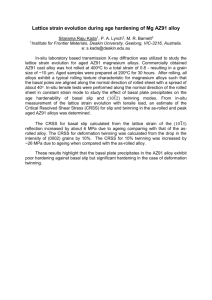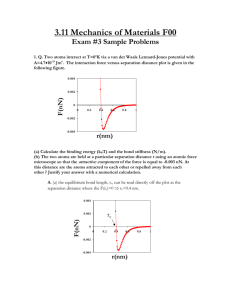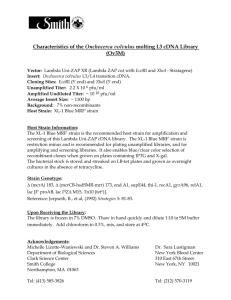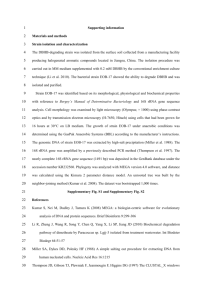Effect of Heat Treatment Conditions on the High Temperature
advertisement
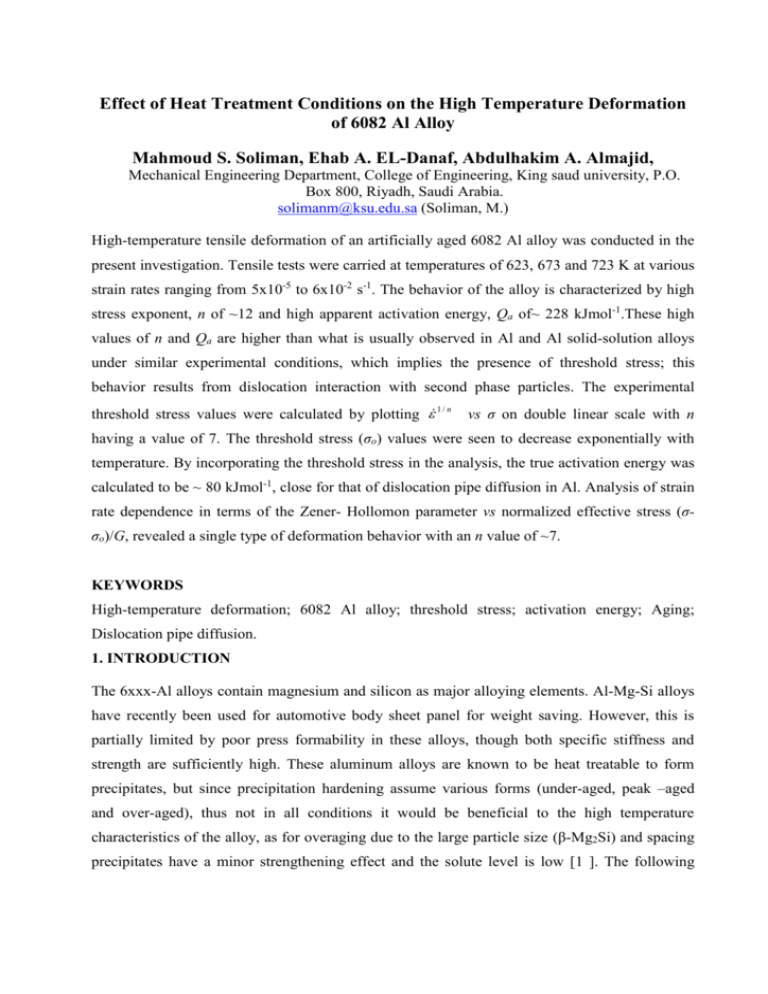
Effect of Heat Treatment Conditions on the High Temperature Deformation of 6082 Al Alloy Mahmoud S. Soliman, Ehab A. EL-Danaf, Abdulhakim A. Almajid, Mechanical Engineering Department, College of Engineering, King saud university, P.O. Box 800, Riyadh, Saudi Arabia. solimanm@ksu.edu.sa (Soliman, M.) High-temperature tensile deformation of an artificially aged 6082 Al alloy was conducted in the present investigation. Tensile tests were carried at temperatures of 623, 673 and 723 K at various strain rates ranging from 5x10-5 to 6x10-2 s-1. The behavior of the alloy is characterized by high stress exponent, n of ~12 and high apparent activation energy, Qa of~ 228 kJmol-1.These high values of n and Qa are higher than what is usually observed in Al and Al solid-solution alloys under similar experimental conditions, which implies the presence of threshold stress; this behavior results from dislocation interaction with second phase particles. The experimental threshold stress values were calculated by plotting 1 / n vs σ on double linear scale with n having a value of 7. The threshold stress (σo) values were seen to decrease exponentially with temperature. By incorporating the threshold stress in the analysis, the true activation energy was calculated to be ~ 80 kJmol-1, close for that of dislocation pipe diffusion in Al. Analysis of strain rate dependence in terms of the Zener- Hollomon parameter vs normalized effective stress (σσo)/G, revealed a single type of deformation behavior with an n value of ~7. KEYWORDS High-temperature deformation; 6082 Al alloy; threshold stress; activation energy; Aging; Dislocation pipe diffusion. 1. INTRODUCTION The 6xxx-Al alloys contain magnesium and silicon as major alloying elements. Al-Mg-Si alloys have recently been used for automotive body sheet panel for weight saving. However, this is partially limited by poor press formability in these alloys, though both specific stiffness and strength are sufficiently high. These aluminum alloys are known to be heat treatable to form precipitates, but since precipitation hardening assume various forms (under-aged, peak –aged and over-aged), thus not in all conditions it would be beneficial to the high temperature characteristics of the alloy, as for overaging due to the large particle size (β-Mg2Si) and spacing precipitates have a minor strengthening effect and the solute level is low [1 ]. The following precipitation sequence was suggested in the 6xxx alloys [2]: (sss) GP zones ’’needles ’ rods + lath-like particles +Si (various morphologies), where (sss) is the supersaturated solid solution and GP zones are spherical clusters with unknown structure. Hot working ( = 10-2 to 10+2 s-1) of pure metals and metallic solid-solution alloys, occur at high temperature (T> 0.5 Tm, where Tm is the absolute melting point) and under the steady state condition the so-called power law (Eq. 1 [3, 4]) is used to predict the stress dependence of strain rate, as exp Qa RT A n Z (1) where is the flow stress, n is the stress exponent , Qa is the apparent activation energy , R is the universal gas constant, T is the absolute temperature, A is a constant and Z is the ZenerHollomon parameter. For Al-Mg and Al-Cu solid-solution alloys which exhibit large solid solution hardening (high atomic –misfit parameter), the measured values of n are close to 3, however, for pure metals and some solid solution alloys, usually with low atomic-misfit parameter, the values of n are close to 5. Comparing the hot formability of aluminum binary solid-solution alloys with that of aluminum alloys produced by ingot metallurgy (IM), powder metallurgy (PM) and of aluminum-based metal-matrix composites [5, 6] suggests that the latter materials are characterized by the presence of the threshold stress o, resulting from the interaction of the fine dispersed particles in these alloys with the moving lattice dislocations. Under this condition, the deformation process is not driven by the applied stress but rather by an effective stress e (= -o).Under this condition, high values for n (> 5) and Qa were reported. The objective of the present study is to examine in detail the high temperature deformation of an artificially-aged 6082 Al alloy over a wide range of strain rates and temperatures to examine the presence of the threshold stress and find out the deformation charactrestics of the alloy. This alloy is characterized by the presence of second phase particles Mg2Si. The silicon will be in solid solution only above 530 oC [7]. 2. Experimental Procedure The 6082 Al alloy has the following composition in wt. % as : 0.99 Mg, 1.46 Si, 0.58 Mn, 0.36 Fe, and rest is Al. The room-temperature mechanical properties are yield strength of 250 MPa, ultimate strength of 300 MPa and ductility of 10%. High temperature tensile tests were carried out after artificial aging; the alloy was solution treated at 843 K for 2 hrs, water quenched and aged for 5hrs at the respective testing temperature. This treatment was intended to produce stable substructure of incoherent precipitate of Mg2Si particles [8]. Flat tensile specimens of 12 mm gage length and 5x3 mm2 cross section area were machined such that the tensile axis was parallel to the rolling direction. The tension tests were carried out on a computer-controlled Instron machine, model 1197 with a resistance furnace containing three heating zones. All specimens were tested in air and soaked in the furnace at the testing temperature for 5 minutes before testing to establish thermal equilibrium. Three temperatures of 623, 673 and 723 K were used; these temperatures were selected as they simulate the real industrial forming conditions of this alloy. The temperature was controlled using a thermocouple connected to the middle of the gauge section. At each temperature different constant speeds were used to impose initial strain rates in the range of 5x10-5 s-1 to 6x10-2 s-1. The strain rates quoted thereafter represent the initial strain rates calculated from the initial gage length of the specimens. True stress-strain curves were plotted and the steady state stress, and in some conditions peak flow stress, when steady state do not prevail specially at high strain rates, were determined. 3. RESULTS Fig. 1 shows, as example, the true stress – true strain curves at 673 K for different initial strain rates. Similar curves are observed at other testing temperature. The results show the high strain rate sensitivity exhibited by the alloy at these temperatures. The true stress – strain response can be divided into three regions. In region I, strain hardening region where the stress increases with strain until it reaches almost constant value in region II that represents the steady-state stress at the applied strain rate. In region III, necking and/or cracking occurs leading to a decrease in the flow stress and thereafter fracture. The stress dependence of the strain rate under steady state condition at constant temperature is determined by plotting the strain rate, as a function of the steady state stress, on a double logarithmic scale. Fig. 2 shows this form of plot for the different temperatures. Examination of the data of this figure reveals that for the range of strain rates and temperatures tested the data points fall on line segments with stress exponent of ~ 12. Using Eq. 1, the apparent activation energy Qa can be calculated at constant strain rate by plotting log σ vs (1/T) at two different strain rates as shown in Fig3. The data points at constant strain rate fall on a segment of straight line whose slope is equal to ( Qa 2.3nR ), which gives Qa an average value of ~ 228 kJmol-1. In calculating Qa , the value of n was taken as 12 as inferred from Fig. 2. Fig. 3 shows the results of ductility measurements in which the elongation at fracture ef % (= Lf /Lo, where Lf is the increase in length at fracture and Lo is the initial length of the specimen), is plotted as a function of initial strain rate at various testing temperatures. As seen in the figure, the ductility values generally increase with temperature and strain rate. This behavior is similar to that previously reported for aluminum alloys [9]. 4. DISCCUSION The threshold-stress behavior is characterized by two points [5]: (i) a high value of stress exponent, n that continuously increases with decreasing stress and (ii) a high value of activation energy above that reported for self diffusion. While the second point is clearly obvious in the results of the present investigation, point one is not. Fig. 2 shows that the value of n is independent of stress and temperature and has a constant value of 12. This lack of agreement with point one may be attributed to the limited range of strain rate applied in the present investigation. This behavior is similar to that recently reported for Al-17 Si alloy [10]; constant n value ~ 5 and high activation energy ( Q = 210 kJmol-1). This high value of n for the present alloy is higher than what is usually reported for binary Al-Mg alloys (n =3) at similar temperatures and strain rates [11].The reason for this difference in values of n may arise from the presence of threshold stress, due to the interaction of dislocation with second phase particles (Mg2Si) present in 6082 Al alloy. This possibility is explored by plotting 1 / n vs. using a double linear scale as shown in Fig. 4. Three different of values of n: 3, 5 and 7 were used in accordance with various rate controlling processes. For the value of n= 7, the data points fall on a segment of straight line whose extrapolation to zero strain rate gives the value of o . Similar figures were plotted for other temperatures. The values of o are 8.8, 13.2, 17.9 MPa at 723, 673 and 623K, respectively. The present results along with previous studies [7-9, 28] suggest that o is a function of temperature and it decreases with increasing temperature. The temperature dependence of the normalized threshold stress (o/G) is shown in Fig. 5 where log (o/G) is plotted vs. (1/T). The value of the shear modulus, G for the alloy as a function of temperature is taken as that for pure Al, G =3.022x104 – 16 T (MPa) [16]. This dependence can be expressed as o G Bo exp Qo RT (3) where Bo and Qo are constants having the values of 4x10-6 and 31 kJmol-1, respectively. This behavior is similar to that observed in a number of powder metallurgy Al alloys and Al metalmatrix composites [28, 29]. When the strain rates are plotted as a function of the effective stress(σ- σo), the stress exponent n inferred is close to ~7 as shown in Fig. 6. Under the presence of threshold stress, Eq. 1 can be modified such that the applied stress is replaced by an effective stress, (σ- σo).It has been shown recently, at constant strain rate, that the true activation energy Q can be written in the form [ ] G o n ln T G QR 1 T (4) Eq. 4 is used to calculate the true activation energy as shown in Fig. 7. The value of Q was determined at two various strain rates in the temperature range of 623-723 K. As shown in the figure the data points fall on segments of parallel straight lines giving Q a constant value independent of strain rate. The average value of Q was calculated as 80 kJmol-1. This value is very close to that reported for dislocation pipe diffusion of in Al [31, 32]. Using the true activation energy, the Zener-Hollomon parameter is plotted vs the normalized effective stress ( o G ) in Fig.8. As shown in the figure, the data points coalesce on one segment of straight line with a slope of ~7. CONCLUSIONS 1. The deformation behavior of an artificially aged AA6082 Al alloy was examined at temperatures ranging from 623- 723 K in the strain rate range from 10-5 to 10-2 s−1. The value of n and Qa were ~12 and 228 kJmol-1, respectively. 2. Analysis of experimental data of the alloy revealed the presence of a threshold stress that decreases with temperature with an energy term, Qo, 23 kJmol-1. 3. By incorporating the threshold stress and the true activation energy into the analysis, a plot of Zener-Hollomon parameter vs normalized effective stress yielded a stress exponent, n of ~7. 4. The calculated true activation energy was close to that for pipe diffusion of in Al and the n value being 7 suggested that pipe diffusion of dislocations is the rate controlling mechanism. 5. Enhanced ductility was observed by increasing temperature and strain rate. References 1 International J plasticity 2 C.D. Marioara, S.J. Anderson, J. Jansen and H.W. Zandbergen, Acta Materialia 51 (2003) 789-796. 3 M.E. Kassner and M.-T. Perez-Prado, Prog. Mater. Sci. 45 (2000) 1. 4 F.A. Mohamed and T.G. Langdon, Acta Metallurgica 22 (1974) 779. 5 F. A. Mohamed, Mater Sci Eng A 245(1998) 242. 6 E. Evangelista and S. Spigarelli, Metall. Mater. Trans. A, 33A, (2002) 373. 7 B. Ronning, K. Nord-Varhaung, T, Furu and E. Nes, Mater. Sci. Forum, 331-337 (2000) 571. 8 G. Mrowka-Nowotnik and J. Sieniawski, J. Mater Process. Tech. 162-163 (2005) 367-372. 9 Tallef 10 S. Spigarelli, E. Evangelista and S. Gucchieri, Mat Sci Eng A 387-389 (2004) 702. 11 H. Oikawa, H. Sato and K. Maruyama, Mat Sci and Eng 75 (1985) 21. 12 13 E. Kovacs-Csetenyi, N.Q. Chinh and I. Kovacs, Mater. Sci. Forum 217-222 (1996) 1175. 2. S. Spigarelli, E. Evangelista and H.J. McQueen, Scripta Materialia 49 (2003) 179. 3. G. Mrowka – Nowotnik and J. Sieniawski, J. Mater Processing Technology 162-163 (2005) 367. 4. 5. . . 6. P. Yavari, F.A. Mohamed and T.G. Langdon, Acta Metallurgica 29 (1981) 1495. 7. M.S. Soliman and F.A. Mohamed, Mat Sci and Eng 55 (1982) 111. 8. H. Oikawa, K. Honda and S. Ito, Mat Sci and Eng 64 (1984) 237. 9. H. Sato and H. Oikawa, Scripta Metallurgica, 22 (1988) 87. 10. B. Chaudhury and F.A. Mohamed, Mat Sci and Eng A 101 (1988) 13. 11. B. Chaudhury and F.A. Mohamed, Metall Trans A. 18 (1987) 2105. 12. M.S. Soliman, Mat Sci and Eng A 201 (1995) 111. 13. F. A. Mohamed, Mater Sci Eng 61 (1983) 149. M.S. Soliman and F.A. Mohamed, Metall Trans A, 15A (1984) 1893. 400 C 1.28E-2 1/s 1.28E-3 1/s 2.56E-4 1/s 6.41E-5 1/s True Stress, MPa 40 35 30 25 20 15 10 5 0 Strain Rate, 1/s 14. 1.E-01 723 K 673 K 623 K 1.E-02 1.E-03 1.E-04 1.E-05 10 0 0.1 0.2 0.3 100 0.4 Stress, MPa True Strain Fig.1 Fig.2 80 Elongaion% Stress ( MPa) 100 10 0.0128/s 60 40 20 6.4E-5/s 0 1.E-05 1 1.3 1.4 1.5 1.6 723 K 673 K 623 K 1.E-04 1.E-03 1.E-02 1.E-01 Strain Rate, 1/s 1.7 1000/T (1/K) Fig.4 0.6 0.5 n=3 n=5 n=7 0.4 0.3 0.2 0.1 0 10 20 30 40 Normalized Threshold Stress (Strain Rate)^1/n Fig.3 0.001 0.0001 0.0012 0.0016 1/T, 1/K Stress, MPa Fig.5 0.0014 Fig.6 0.0018 1.E+05 723 K 673 K 623 K 1.E-02 1.E-03 1.E+04 Z,1/s Strain Rate, 1/s 1.E-01 1.E-04 1.E+02 1.E-05 1 10 1.E+01 1.E-04 100 Effective Stress, MPa Fig.7 723 K 673 K 623 K 1.E+03 1.E-03 1.E-02 Normalized Effective Stress Fig.8


